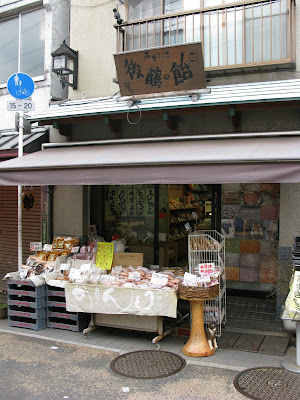
 Uguisudani is two minutes on from Nippori, and one thing you notice in the station on the way out are pictures of birds like the one above, because Uguisudani roughly translates as 'Valley of the Bush Warblers'. Several other flags and posters in the area carry similar pictures, juts so you don't forget where you are.
Uguisudani is two minutes on from Nippori, and one thing you notice in the station on the way out are pictures of birds like the one above, because Uguisudani roughly translates as 'Valley of the Bush Warblers'. Several other flags and posters in the area carry similar pictures, juts so you don't forget where you are. Monday was a grey, drizzly day, and to start off my walk around the area I headed to the Yanaka side, and joined up with part of the neighbourhood I reached last week.
Monday was a grey, drizzly day, and to start off my walk around the area I headed to the Yanaka side, and joined up with part of the neighbourhood I reached last week.


 This building is the old sake house which dates back about a hundred years and now serves as a kind of small museum and information desk (except Mondays).
This building is the old sake house which dates back about a hundred years and now serves as a kind of small museum and information desk (except Mondays).
 Nearby I noticed this 'Rest Station, a little shaded area for tired visitors to rest their weary feet. You can also buy postcards and leave the money in little box on one of the benches.
Nearby I noticed this 'Rest Station, a little shaded area for tired visitors to rest their weary feet. You can also buy postcards and leave the money in little box on one of the benches. I popped into a great little cafe called Yanaka Bossa and had a curry set for lunch which was a perfect way to warm up.
I popped into a great little cafe called Yanaka Bossa and had a curry set for lunch which was a perfect way to warm up. A few blocks in the direction of Ueno Park brought me to Tokyo Geijitsu University, the university of art, and they were holding their graduation works exhibition, so I decided to take a look, pleased that at least one museum or gallery wasn't closed on Mondays.
A few blocks in the direction of Ueno Park brought me to Tokyo Geijitsu University, the university of art, and they were holding their graduation works exhibition, so I decided to take a look, pleased that at least one museum or gallery wasn't closed on Mondays.
 There were many kinds of work on display over a number of floors, and though you're not usually supposed to take pictures in exhibitions, I noticed that several others were happily snapping away, so I decided to take a couple of pictures too. Sadly, because my kanji isn't too great, I wasn't able to note the names of the artists, as I would have liked to have credited them here. The above works were a series of chairs made out of different types of shredded publication. For example, one is entirely made up of shredded novels, another fashion magazines and so on.
There were many kinds of work on display over a number of floors, and though you're not usually supposed to take pictures in exhibitions, I noticed that several others were happily snapping away, so I decided to take a couple of pictures too. Sadly, because my kanji isn't too great, I wasn't able to note the names of the artists, as I would have liked to have credited them here. The above works were a series of chairs made out of different types of shredded publication. For example, one is entirely made up of shredded novels, another fashion magazines and so on.

 One the steps outside the university, though not connected to the exhibition.
One the steps outside the university, though not connected to the exhibition. The International Library of Children's Literature
The International Library of Children's Literature I wandered back toward the station and out the other side to an area that was much more built up and grey.
I wandered back toward the station and out the other side to an area that was much more built up and grey. This sign was sadly not indicative of the weather on Monday.
This sign was sadly not indicative of the weather on Monday. A tiny taco-yaki shop wedged in a corner to take advantage of every inch of land.
A tiny taco-yaki shop wedged in a corner to take advantage of every inch of land. The blocks next to the station on this side of the tracks are filled with two types of establishment. Firstly you have some small eating and drinking establishments ~ all closed in the middle of the afternoon of course.
The blocks next to the station on this side of the tracks are filled with two types of establishment. Firstly you have some small eating and drinking establishments ~ all closed in the middle of the afternoon of course.
 The other dominant establishment in the area is the love hotel, and there are literally dozens of them crammed in the maze of streets next to the station, and apparently Uguisudani is famous for this. By day they look fairly drab and lifeless, but by night they will all be lit up in gaudy neon trying to attract customers.
The other dominant establishment in the area is the love hotel, and there are literally dozens of them crammed in the maze of streets next to the station, and apparently Uguisudani is famous for this. By day they look fairly drab and lifeless, but by night they will all be lit up in gaudy neon trying to attract customers.













































